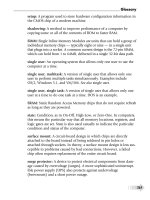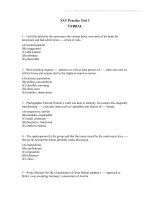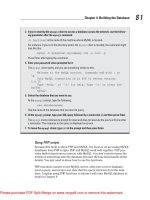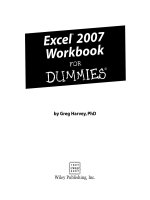Workbook for dummies 3 ppt
Bạn đang xem bản rút gọn của tài liệu. Xem và tải ngay bản đầy đủ của tài liệu tại đây (121.08 KB, 6 trang )
• A •
abbreviations, capitalization, 118–119
academia, capitalization, 115–116
addresses, commas, 70–71
adjectives
about, 189
versus adverbs, 179–181
answers, 184–187
practice, 180–183
adverbs
about, 189
versus adjectives, 179–181
answers, 184–187
practice, 180–183
affect, 255
almost, 189
among, 257
amount, 257
answers
adjectives, 184–187
adverbs, 184–187
apostrophes, 96–99
capital letters, 121–124
commas, 76–80
comparisons, 211–214, 222–225
descriptions, 199–203
grammar, 281–291
parallel structure, 237–241
pronoun cases, 135–140
pronouns, 43–47, 150–154
punctuation, 87–89
quotation marks, 108–112
sentences, 59–63, 251–254
subject-verb pairing, 30–34
verb moods, 172–175
verb tenses, 161–165
verbs, 17–21
word traps, 263–266
apostrophes
about, 91
answers, 96–99
contractions, 91–93
possession, 93–94
possessive pronouns, 91
practice, 92–95
articles, 182–183
as, 256
• B •
bad, 181–182, 207
badly, 181–182
best, 207
better, 207
between, 257
business, capitalization, 115–116
• C •
can, 15
capitalization
abbreviations, 118–119
about, 113
academia, 115–116
answers, 121–124
business, 115–116
company names, 115–116
education, 115–116
geographic capitals, 117–118
headline style, 116
literary works, 116–117
media works, 116–117
names, 113–115
practice, 114–120
scientific works, 116–117
sentence style, 116
titles, 113–115
choppy sentences, 245–246
college, grammar and, 1
colons, 85
comma splice, 273
commas
about, 67
addresses, 70–71
answers, 76–80
dates, 70–71
Index
38_599321 bindex.qxp 4/3/06 8:53 PM Page 293
commas (continued)
descriptions, 73–74
direct address, 69–70
interrupters, 71–72
introductory expressions, 71–72
lists, 67–69
practice, 68–75
semicolons and, 68
common expressions, 258–260
companies
name capitalization, 115–116
pronouns, 143–144
comparative comparisons, 205–207
comparisons
about, 205, 215
absolute, 208–209
answers, 211–214, 222–225
comparative, 205–207
double, 219–221
-er ending, 205–207
-est ending, 205–207
illogical, 217–219
incomplete, 215–217
irregular, 207–208
practice, 206–210, 216–221
superlative, 205–207
complete sentences, 56–57
complete thoughts, sentences, 51–52
complicated sentence structure, 270
computer grammar checking, 275
computer spell checking, 275
conjunctions, parallel structure, 234–236
connectors, 81–82
contractions
apostrophes, 91–93
versus possessive pronouns, 38–39
could, 15
• D •
dangling descriptions
about, 194–196
over correction, 270–271
dangling modifiers, 194
dashes, 82–83
dates, commas, 70–71
descriptions
about, 189
answers, 199–203
commas, 73–74
dangling, 194–196
misplaced, 192–194
practice, 190–198
vague, 196–197
descriptive grammar, 1
direct addresses, commas, 69–70
direct quotations, 101–103
distancing, quotation marks, 101
dividers, 81–82
double comparisons, 219–221
double meanings, 40–42
• E •
education, capitalization, 115–116
effect, 255
embedding one quotation inside another,
103–105
endmarks, sentences, 49, 55–56
English as second language, 2
English teachers, 1–2
enough is enough, over-correction, 271
-er ending, comparison, 205–207
-est ending, comparison, 205–207
even, 189
• F •
farther, 255
fewer, 257
functional grammar, 1
further, 255
future perfect tense, 11
future tense verbs, 9
• G •
geographic capitalization, 117–118
gerunds, 158
good, 181–182, 207
grammar
answers, 281–291
mistakes, 277–291
practice, 277–280
value of, 1
294
English Grammar Workbook For Dummies
38_599321 bindex.qxp 4/3/06 8:53 PM Page 294
• H •
had, 269
have, 270
headline style capitalization, 116
helper verbs, 15–16
hyphenated owners, apostrophes, 94
hyphens, 81–82
• I •
I capitalization, 273
I versus me overcorrection, 270
illogical comparisons, 217–219
imperative verb mood, 168–169
imply, 256
improper references, pronoun, 146–148
incomplete comparisons, 215–217
incomplete sentences, 273
independent words, 261
indicative verb mood, 167–168
infer, 256
infinitives, 10, 11, 158
-ing nouns, 132–133
interrupters, comma, 71–72
introductory elements, sentences, 243–245
introductory expressions, commas, 71–72
irregular comparisons, 207–208
irregular nouns, 23
irregular plural owners, apostrophes, 93
irregular verbs
forms, 12–14
practice, 13, 14
• J •
joining sentences, 52–55
joint ownership, apostrophes, 93
just, 189
• L •
lay, 260
least, 205
less, 257
lie, 260
like, 256
lists, commas, 67–69
literary works capitalization, 116–117
• M •
many, 257
may, 15
media works capitalization, 116–117
might, 15
misplaced descriptions, 192–194
money, 94
more than, 257
most, 205
much, 257
must, 15
• N •
name capitalization, 113–115
nearly, 189
new words, 274
not, 189
nouns, plural, 23–24
number, 257
• O •
object pronouns, 127–129
objects of prepositions, 131–132
only, 189
open style punctuation, 67
organization pronouns, 143–144
over-correction
about, 269
complicated sentence structure, 270
dangling descriptions, 270–271
enough is enough, 271
had, 269
have, 270
I versus me, 270
semicolons, 271
speaking passively, 270
they and their, 271
whom for who, 269
writing passively, 270
295
Index
38_599321 bindex.qxp 4/3/06 8:53 PM Page 295
• P •
pairing, subject-verb
answers, 30–34
matching, 26–28
practice, 25–29
sentences, 49–51
subjects, 24–26
verbs, 24–26
parallel structure
about, 229–231
answers, 237–241
conjunctions, 234–236
person, 232–234
practice, 230–236
tense, 232–234
voice, 232–234
participles, verb tenses, 158
past perfect tense, 11
past tense verbs, 9, 155–157
perfect tenses, 11–12
person, parallel structure, 232–234
plain tense, 9
plural nouns, 23–24
plural owner, apostrophes, 93
plural pronouns, 35–37
possessive pronouns, 37–39
possessives
apostrophes, 93–94
pronouns, 141–143
practice
adjectives, 180–183
adverbs, 180–183
apostrophes, 92–95
capital letters, 114–120
commas, 68–75
comparisons, 206–210, 216–221
descriptions, 190–198
grammar, 277–280
irregular verbs, 13, 14
parallel structure, 230–236
perfect tenses, 11–12
pronoun cases, 128–134
pronouns, 36–37, 142–149
punctuation, 82–86
quotation marks, 102–107
sentences, 50–58, 244–250
subject-verb pairing, 25–29
tenses, 10
verb moods, 167–171
verb tenses, 156–160
verbs, 260–262
word traps, 256, 258–260
present perfect tense, 11
present tense verbs, 9, 157–158
progressive verbs, 9
pronoun cases
about, 127
answers, 135–140
to be sentences, 130–131
-ing nouns, 132–133
object pronouns, 127–129
objects of prepositions, 131–132
practice, 128–134
reflexive pronouns, 128
self pronouns, 128
subject pronouns, 127–129
who, 129–130
whom, 129–130
pronouns
about, 35, 141
answers, 43–47, 150–154
companies, 143–144
versus contractions, 38–39
correct use, 274
double meanings, 40–42
improper references, 146–148
organizations, 143–144
plural, 35–37
possessive, 37–38, 141–143
practice, 36–37, 142–149
singular, 35–37
that, 144–145
which, 144–145
who, 144–145
proofreading, 275
punctuation
about, 81
answers, 87–89
colons, 85
connectors, 81–82
dashes, 82–83
dividers, 81–82
hyphens, 81–82
practice, 82–86
semicolons, 84
296
English Grammar Workbook For Dummies
38_599321 bindex.qxp 4/3/06 8:53 PM Page 296
• Q •
quantity words, 257
quotation marks
about, 101, 274
answers, 108–112
direct quotations, 101–103
distancing, 101
embedding one quotation inside another,
103–105
practice, 102–107
speaker tags, 102
titles, 101, 105–106
• R •
redundancy, sentences, 248–250
reflexive pronouns, 128
repetition, 275
reversed sentence patterns, 247–248
run-on sentences, 273
• S •
scientific works, capitalization, 116–117
self pronouns, 128
semicolons
about, 84
lists, 68
over-correction, 271
sentences
about, 49, 243
answers, 59–63, 251–254
choppy, 245–246
complete, 56–57
complete thoughts, 51–52
endmarks, 49, 55–56
introductory elements, 243–245
joining, 52–55
practice, 50–58, 244–250
redundancy, 248–250
reversed sentence patterns, 247–248
style, 116
subject-verb pair, 49–51
separate ownership, apostrophes, 94
set, 260
should, 15
similar words, 255–256
singular owner, apostrophes, 93
singular pronouns, 35–37
sit, 260
slang, 274
speaker tags, quotation marks, 102
speaking passively, 270
style manuals, 113
subject pronouns, 127–129
subject-verb pairing
answers, 30–34
matching, 26–28
practice, 25–29
sentences, 49–51
subjunctive verb mood, 169–170
such as, 256
superlative comparisons, 205–207
• T •
tenses. See verb tenses
that, 144–145
their, 271
they, 271
time, 94
titles
capital letters, 113–115
quotation marks, 101, 105–106
to be
about, 13–14
sentences, 130–131
to have, 13–14
• V •
vague descriptions, 196–197
verb moods
about, 167
answers, 172–175
imperative, 168–169
indicative mood, 167–168
practice, 167–171
subjunctive mood, 169–170
297
Index
38_599321 bindex.qxp 4/3/06 8:53 PM Page 297
verb tenses
about, 9, 155
answers, 161–165
future perfect, 11
gerunds, 158
infinitives, 158
parallel structure, 232–234
participles, 158
past, 155–157
past perfect, 11
practice, 10, 156–160
present, 157–158
present perfect, 11
verbs
about, 9
answers, 17–21
helpers, 15–16
irregular verb forms, 12–14
matching with subjects, 26–28
practice, 260–262
word traps, 260–261
voice, parallel structure, 232–234
• W •
well, 181–182
which, 144–145
who, 129–130, 144–145
whom, 129–130, 269
word traps
about, 255
answers, 263–266
common expressions, 258–260
independent words, 261
practice, 256, 258–260
quantity words, 257
similar words, 255–256
verbs, 260–261
worse, 207
worst, 207
would, 15
writing passively, 270
298
English Grammar Workbook For Dummies
38_599321 bindex.qxp 4/3/06 8:53 PM Page 298









